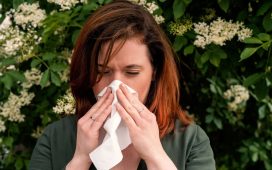The NHS must end the ‘discrimination’ that means three million people aged between 66 and 69 are unable to get the shingles vaccine, campaigners urge.
The crucial jab – which greatly reduces the chances of developing the extremely painful viral skin condition – is offered to everyone when they turn 65 as well as those aged between 70 and 80.
This is due to limited supplies of the vaccine, called Shingrix, which has made Government advisers prioritise certain age groups in order to maximise take-up.
The Mail on Sunday has learned that the highly effective drug will soon be offered to all over-80s, too. It means that 66- to 69-year-olds, who are as much at risk as 65 and 70-year-olds, will become the only cohort of older adults barred from getting the jab.

The crucial jab greatly reduces the chances of developing the extremely painful viral skin condition (stock image)

The jab is offered to everyone when they turn 65 as well as those aged between 70 and 80
This newspaper last week reported the concerns of health officials that too few people were coming forwards to take up Shingrix.
But The Mail on Sunday has since been contacted by hundreds of readers claiming they are unable to get the vaccine.
Many complained that despite having recently suffered from shingles, they were banned from receiving the jab on the NHS as they were aged 66 to 69.
And a number of eligible patients raised the alarm on the fact that some GP practices were not offering Shingrix – either because the jab was unavailable on the back of its worldwide popularity or because they had been instructed to first use up their stock of a less effective, earlier vaccine.
Some younger readers with underlying health conditions were wrongly told they were not eligible for the jab, despite the fact that the NHS is supposed to offer Shingrix to people over 50 with weakened immune systems.
One reader, Alastair Barrow, sums up the frustration. The 66-year-old wants the drug because he suffered a bad bout of shingles in 2019, but was two months too old when the NHS vaccination programme was launched.
Recalling the painful, itchy rash that lasted for weeks on the side of his face, Alastair says: ‘I’ve never felt so ill in my life.
Even today I can still feel where the rash was because the disease damaged the nerves. I dread getting shingles again.
‘It seems ridiculous that I’ll have to wait another four years to get the vaccine. My wife, who is younger than me, will receive it before me under this system. It doesn’t seem to make sense.’
Senior citizen campaign group Silver Voices is calling on the NHS to ditch the age restriction.
‘Millions are at risk of missing out on this vital vaccine,’ says Dennis Reed, the charity’s director. ‘Shingles is debilitating and can lead to death. I know people who never fully recovered.
‘Those aged 66 to 69 are at the stage where they are deemed at-risk of getting shingles but they aren’t being offered the jab.
This is another example of age discrimination in the NHS. We want the Health Service to see sense and put an end to it.’
More than 50,000 elderly Britons develop shingles every year, and nearly one in four will suffer from it at some point in their life.
The condition is linked to chicken-pox, the highly contagious disease that leads to itchy, spotty rashes.

TV presenter Eamonn Holmes (pictured) suffered shingles in 2018

Holmes was forced to take time off from ITV’s This Morning after the rash covered his face and caused intense stabbing pains
If caught at a young age, chickenpox is not usually serious, but the virus that causes it – varicella-zoster – remains in the spinal-cord nerves for life.
The immune system keeps it at bay, but its ability to do so weakens with age, potentially allowing the virus to reactivate and attack the body again.
A blotchy, red rash that blisters usually appears on one side of the chest or abdomen, but can crop up anywhere on the body.
They are often accompanied by headaches and nausea, and the rash can be extremely painful for weeks.
TV presenter Eamonn Holmes suffered shingles in 2018. He was forced to take time off from ITV’s This Morning after the rash covered his face and caused intense stabbing pains. Doctors even feared he could lose his eyesight.
The condition is known to kill, too, with about 50 Britons aged over 70 dying each year.
Until recently, this age group were offered a shingles jab on the NHS called Zostavax. While it was considered to be effective, it reduced the risk of shingles by only 50 per cent. Studies also showed that this protection waned to a negligible level as patients aged.
But studies in 2020 revealed that Shingrix, created by British pharmaceutical firm GlaxoSmithKline (GSK), reduces the risk of shingles by more than 90 per cent.
Crucially, studies show the jab, which is given as two doses about six months apart, provides strong protection in people as old as 90.
The NHS has been offering Shingrix in place of Zostavax since September. The jab is in high demand across the globe, though, and the Health Service was forced to put a limit on the number of patients who could get the vaccine.
All patients turning 65 will now be offered Shingrix – and will remain eligible until they are 80. But those who turned 65 before September 1, 2023 will have to wait until they are 70 for the vaccine.
And patients aged between 70 and 80 who have not had Zostavax are also eligible to receive Shingrix as part of a catch-up campaign.

A blotchy, red rash that blisters usually appears on one side of the chest or abdomen, but can crop up anywhere on the body (stock image)

Rashes are often accompanied by headaches and nausea, and the rash can be extremely painful for weeks (stock image)

Studies in 2020 revealed that Shingrix, created by British pharmaceutical firm GlaxoSmithKline (GSK), reduces the risk of shingles by more than 90 per cent (stock image)
Take-up of the jab has historically been low, with fewer than half of all 71-year-olds inoculated.
The NHS plans to extend eligibility to include all those aged 60 and up by September 2033. But there are no schemes in motion to allow patients who have already received Zostavax to be rejabbed with the superior Shingrix.
Some experts admit the rules are confusing, but others argue that they are logical.
‘Shingrix is a great vaccine, but supplies are limited,’ says Prof Judith Breuer, a virologist at University College London. ‘It’s complicated to produce and there is a massive global demand for the jab.
‘It’s been decided that 65 will be the age at which everyone gets offered the vaccine, but we also need to protect the most vulnerable patients – those aged over 70 – as quickly as possible, too.
‘Unfortunately, this means that people aged 66 to 69 will have to wait a few years. It’s annoying for them, but it’s for a good reason.’
However, other experts warn that those in this age bracket are at risk of developing shingles.
‘This approach does seem rather confused,’ says Prof Richard Tedder, a retired virologist who previously worked at Public Health England – now known as the UK Health Security Agency.
‘People in this age group are vulnerable to shingles. They’re less at risk than people in their 70s, but they are certainly at risk.
‘Ideally you’d give this vaccine to everyone aged over 50, but clearly there aren’t enough available.’
One patient who’s well aware of this is Kathy Relf. The 70-year-old says she was told by her GP that Shingrix was reserved for patients with underlying conditions and weakened immune systems. Instead, she was offered Zostavax.
And Ivor Hendry, 71, says his Norwich GP was only carrying out five shingle vaccinations a week and that he would have to wait to be called for the jab.
A spokesman for GSK claimed there are currently no Shingrix supply issues in the UK.
The Mail on Sunday has learned that vaccine chiefs are planning to expand the offer of Shingrix jabs to patients over the age of 80.
The vaccine was previously not given to this more elderly group because it was uncertain whether it provided them with strong immunity against shingles.
However, according to minutes from the most recent meeting of the Joint Committee on Vaccination and Immunisation – the Government’s vaccine advisory group – this will soon change.
The committee agreed that, since this age group was at the highest risk of developing shingles, they should be offered vaccination ‘regardless of cost-effectiveness’.
The plans have outraged charities, including Silver Voices, which likened the situation to the ‘Waspi Women’ scandal – the 3.8 million ladies born in the 1950s who had their state pension age increased from 60 to 65 to be equal to men.
Campaigners argue that poor communication over the changes, which began in 2010, left them with insufficient time to prepare for up to six years longer without their pension, leaving many in a serious financial mire.
They also point out that those who have been left out of the shingles programme are, like the Waspi Women, also born in the 1950s.
Shingrix can be bought privately and at high street pharmacists, including Boots and Superdrug which offer both doses for about £450. But patients say it is outrageous that they should have to pay for a vaccine which is being offered to younger people.
Jacky Murrell, 65, from Beaconsfield, Buckinghamshire, was told by her GP that she was one day too old to receive the vaccine.
‘I’ll have to wait five years for the jab, while my husband – who is three weeks younger – has already had it,’ she says. ‘It’s absurd. I can remember when my grandad had shingles – the pain he was in was horrendous. I’m really worried about getting it, too. So why aren’t I allowed the vaccine?’
A UK Health Security Agency spokesman says: ‘The approach has been used in the effective implementation of previous immunisation programmes. While it may mean some people have to wait until the date that they would have originally been eligible, others will receive the vaccines sooner and will benefit for longer.’











